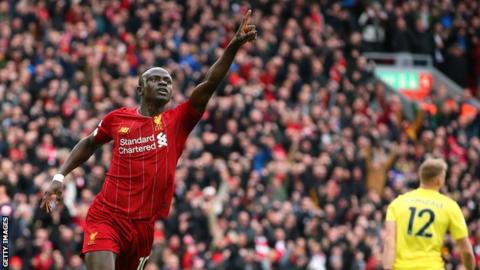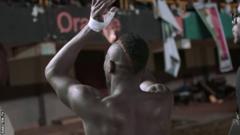
Rejoice football fans – for there is something else to watch in the absence of live sport!
A new documentary – ‘Sadio Mane: Made in Senegal’ – about the Liverpool and Senegal forward, has been released today for free on Rakuten TV.
It’s a reminder of what life was like before football took an indefinite break, and we dare even the most ardent Manchester United fan not to be moved by the story of Mane’s incredible journey.
We liked it a lot anyway. And here are just a few things we learned.
1. Mane had to run away to play football
Perhaps you already know this story, but, as a boy, growing up in a small village called Bambali in Senegal, Sadio Mane’s family weren’t actually that keen on him kicking a ball about for a living.
His father died when he was just seven and he was raised largely by his uncles. He came from a family of imams – Muslim prayer leaders – for whom education was the priority.
“My uncle didn’t want me to play because he thought school was more important. Things got tricky because he didn’t like that,” Mane says.
Mane describes his obsession, playing with objects including grapefruit and stones as a child when footballs weren’t readily available. In his village, as the best player, his nickname was ‘Ballonbuwa’, or ‘ball wizard’.
In 2008, when he was 16, Mane actually ran away to Dakar in secret, to try out for a team there. He was eventually found and brought home, but he made a deal with his family that the next year, there would be no more school and only “football, football, football,” in Mane’s words.
2. His hero growing up was El Hadji Diouf
Sadio Mane would have been 10 years old when Senegal reached the 2002 World Cup quarter-finals and Africa Cup of Nations final, with a team that included stars like Aliou Cisse, Khalilou Fadiga and El Hadji Diouf.
“That was the era of the most epic Senegalese football,” says Mane.
His best friend growing up, Luc, explains that Sadio had two idols: “At the time, Sadio liked Ronaldinho, but also El Hadji Diouf, who really spurred us on to play football.”
Luc adds that Mane told him: “One day, I’ll be at their level.”
One could argue that Mane has already surpassed Diouf – at least in terms of club success at Liverpool. He’s certainly created a better legacy with the Reds than his hero El Hadji, who has developed a bit of an ongoing feud with his former employers in recent years.

3. The weather in Europe was a shock to the system
Mane left Senegal to join the French team, FC Metz, in 2011. The first thing that he noticed on arrival in France, in January, was the wind.
Mane describes his new team-mates’ reaction when he came out of the changing room in a T-shirt.
“They all started laughing and I didn’t understand why,” he says. “They asked, ‘how can you dress like that?'”
He explains that he lasted five minutes before having to return, freezing, to the changing room, only to make his next error: “I put my hand in hot water. That wasn’t good. Oh God, did I suffer that day!”
Mane does say that his time at FC Metz was what made him who he is today. Early on in his time there, he sustained an adductor injury, but decided not to tell anyone because he was so worried that he might be dropped and have to return home.
“It could’ve been the end of my career,” he says.
When he finally had an operation the surgeon who operated on him said the injury “was extremely inflamed”, and that he’d “rarely seen such a bad sports hernia”.
After eight months out, and now free of injury, he started lighting it up with FC Metz. The rest is history, with moves to RB Salzburg, Southampton and Liverpool to follow.
4. Mane made a bad first impression on Jurgen Klopp
In a very candid moment in the documentary, Jurgen Klopp tells us about a bad judgment call he made, as manager of Dortmund when Mane was introduced to him.
“There was a really young guy sitting there. His baseball cap was askew, the blond streak he still has today… he looked like a rapper just starting out. I thought: ‘I don’t have time for this.'”
Harsh. And pretty judgemental!
Klopp is, at least, big enough to admit that he made a mistake: “I’d say I have a pretty good feeling for people, but I was wrong!”
As an aside, it’s quite a pleasing novelty to hear Klopp speaking in his native German throughout this film.
5. Home crowds are sometimes the toughest crowds

“Sadio Mane is only good at his club and not in Senegal.”
“He’s one of Africa’s best players, but he doesn’t show it here. That’s why we can’t support him here.”
These are just some of the takes from the average fan in the street, shown in the film.
He’s built homes for his uncles and built a school and hospital in his home municipality. He’s clearly a role model.
But one thing Mane desperately wants to bring home and has so far not managed is the Africa Cup of Nations. And people won’t let him forget it.
A penalty miss in the quarter-finals of the 2017 Africa Cup of Nations did not help his case. Making the final last year, only to be beaten 1-0 by Algeria also stung.
Still, he hasn’t lost his ambition.
“My goal is to win the Africa Cup of Nations with the Lions. And, naturally, the Premier League. And the Champions League, too. Again, and again.”
There’s still time Sadio.


Follow Us!